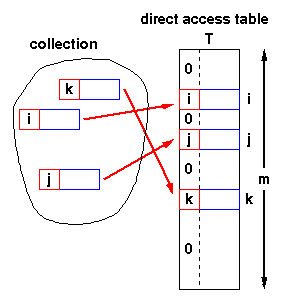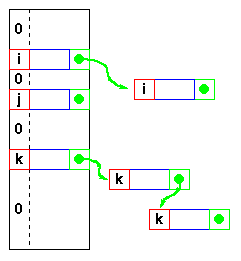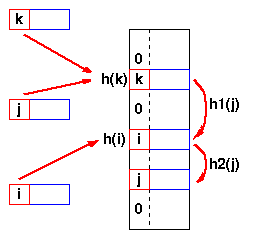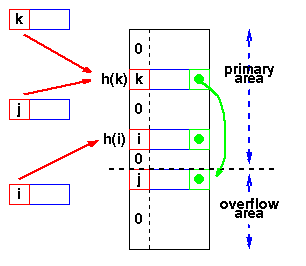关于数据库、Hash 存储、 Hash表
来源:互联网 发布:人物设计软件 编辑:程序博客网 时间:2024/06/05 19:01
1、关于Hash 表
Hash Tables
8.3.1 Direct Address Tables
If we have a collection of n elements whose keys are unique integers in (1,m), where m >= n,
then we can store the items in a direct address table, T[m],
where Ti is either empty or contains one of the elements of our collection.
Searching a direct address table is clearly an O(1) operation:
for a key, k, we access Tk,
- if it contains an element, return it,
- if it doesn't then return a NULL.
- the keys must be unique, and
- the range of the key must be severely bounded.

If the keys are not unique, then we can simply construct a set of m lists and store the heads of these lists in the direct address table. The time to find an element matching an input key will still be O(1).
However, if each element of the collection has some other distinguishing feature (other than its key), and if the maximum number of duplicates is ndupmax, then searching for a specific element is O(ndupmax). If duplicates are the exception rather than the rule, then ndupmax is much smaller than n and a direct address table will provide good performance. But if ndupmax approaches n, then the time to find a specific element is O(n) and a tree structure will be more efficient.

The range of the key determines the size of the direct address table and may be too large to be practical. For instance it's not likely that you'll be able to use a direct address table to store elements which have arbitrary 32-bit integers as their keys for a few years yet!
Direct addressing is easily generalised to the case where there is a function,
which maps each value of the key, k, to the range (1,m). In this case, we place the element in T[h(k)] rather than T[k] and we can search in O(1) time as before.
8.3.2 Mapping functions
The direct address approach requires that the function, h(k), is a one-to-one mapping from each k to integers in (1,m). Such a function is known as a perfect hashing function: it maps each key to a distinct integer within some manageable range and enables us to trivially build an O(1) search time table.
Unfortunately, finding a perfect hashing function is not always possible. Let's say that we can find a hash function, h(k), which maps most of the keys onto unique integers, but maps a small number of keys on to the same integer. If the number of collisions (cases where multiple keys map onto the same integer), is sufficiently small, then hash tables work quite well and give O(1) search times.
Handling the collisions
In the small number of cases, where multiple keys map to the same integer, then elements with different keys may be stored in the same "slot" of the hash table. It is clear that when the hash function is used to locate a potential match, it will be necessary to compare the key of that element with the search key. But there may be more than one element which should be stored in a single slot of the table. Various techniques are used to manage this problem:
- chaining,
- overflow areas,
- re-hashing,
- using neighbouring slots (linear probing),
- quadratic probing,
- random probing, ...
Chaining
One simple scheme is to chain all collisions in lists attached to the appropriate slot. This allows an unlimited number of collisions to be handled and doesn't require a priori knowledge of how many elements are contained in the collection. The tradeoff is the same as with linked lists versus array implementations of collections: linked list overhead in space and, to a lesser extent, in time.
Re-hashing
Re-hashing schemes use a second hashing operation when there is a collision. If there is a further collision, we re-hash until an empty "slot" in the table is found.
The re-hashing function can either be a new function or a re-application of the original one. As long as the functions are applied to a key in the same order, then a sought key can always be located.
Linear probing
One of the simplest re-hashing functions is +1 (or -1), ie on a collision, look in the neighbouring slot in the table. It calculates the new address extremely quickly and may be extremely efficient on a modern RISC processor due to efficient cache utilisation (cf. the discussion of linked list efficiency).The animation gives you a practical demonstration of the effect of linear probing: it also implements a quadratic re-hash function so that you can compare the difference.

h(j)=h(k), so the next hash function,
h1 is used. A second collision occurs,
so h2 is used.
Clustering
Linear probing is subject to a clustering phenomenon. Re-hashes from one location occupy a block of slots in the table which "grows" towards slots to which other keys hash. This exacerbates the collision problem and the number of re-hashed can become large.
Quadratic Probing
Better behaviour is usually obtained with quadratic probing, where the secondary hash function depends on the re-hash index:
on the tth re-hash. (A more complex function of i may also be used.) Since keys which are mapped to the same value by the primary hash function follow the same sequence of addresses, quadratic probing shows secondary clustering. However, secondary clustering is not nearly as severe as the clustering shown by linear probes.
Re-hashing schemes use the originally allocated table space and thus avoid linked list overhead, but require advance knowledge of the number of items to be stored.
However, the collision elements are stored in slots to which other key values map directly, thus the potential for multiple collisions increases as the table becomes full.
Overflow area
Another scheme will divide the pre-allocated table into two sections: the primary area to which keys are mapped and an area for collisions, normally termed the overflow area.
 When a collision occurs, a slot in the overflow area is used for the new element and a link from the primary slot established as in a chained system. This is essentially the same as chaining, except that the overflow area is pre-allocated and thus possibly faster to access. As with re-hashing, the maximum number of elements must be known in advance, but in this case, two parameters must be estimated: the optimum size of the primary and overflow areas. Of course, it is possible to design systems with multiple overflow tables, or with a mechanism for handling overflow out of the overflow area, which provide flexibility without losing the advantages of the overflow scheme.
When a collision occurs, a slot in the overflow area is used for the new element and a link from the primary slot established as in a chained system. This is essentially the same as chaining, except that the overflow area is pre-allocated and thus possibly faster to access. As with re-hashing, the maximum number of elements must be known in advance, but in this case, two parameters must be estimated: the optimum size of the primary and overflow areas. Of course, it is possible to design systems with multiple overflow tables, or with a mechanism for handling overflow out of the overflow area, which provide flexibility without losing the advantages of the overflow scheme. Summary: Hash Table Organization
- Unlimited number of elements
- Unlimited number of collisions
- Overhead of multiple linked lists
- Fast re-hashing
- Fast access through use
of main table space
- Maximum number of elements must be known
- Multiple collisions may become
probable
- Fast access
- Collisions don't use primary table space
- Two parameters which govern performance
need to be estimated
2、关于MySQL 数据库 HASH 分区:
基于用户定义的表达式的返回值来进行选择的分区,该表达式使用将要插入到表中的这些行的列值进行计算。这个函数可以包含MySQL 中有效的、产生非负整数值的任何表达式。
HASH分区主要用来确保数据在预先确定数目的分区中平均分布。在RANGE和LIST分区中,必须明确指定一个给定的列值或列值集合应该保存在哪个分区中;而在HASH分区中,MySQL 自动完成这些工作,你所要做的只是基于将要被哈希的列值指定一个列值或表达式,以及指定被分区的表将要被分割成的分区数量。
要使用HASH分区来分割一个表,要在CREATE TABLE 语句上添加一个“PARTITION BY HASH (expr)”子句,其中“expr”是一个返回一个整数的表达式。它可以仅仅是字段类型为MySQL 整型的一列的名字。此外,你很可能需要在后面再添加一个“PARTITIONS num”子句,其中num 是一个非负的整数,它表示表将要被分割成分区的数量。
CREATE TABLE employees (
id INT NOT NULL,
fname VARCHAR(30),
lname VARCHAR(30),
hired DATE NOT NULL DEFAULT '1970-01-01',
separated DATE NOT NULL DEFAULT '9999-12-31',
job_code INT,
store_id INT
)
PARTITION BY HASH(YEAR(hired))
PARTITIONS 4;
MySQL还支持线性哈希功能,它与常规哈希的区别在于,线性哈希功能使用的一个线性的2的幂(powers-of-two)运算法则,而常规 哈希使用的是求哈希函数值的模数。
线性哈希分区和常规哈希分区在语法上的唯一区别在于,在“PARTITION BY” 子句中添加“LINEAR”关键字,如下面所示:
CREATE TABLE employees (
id INT NOT NULL,
fname VARCHAR(30),
lname VARCHAR(30),
hired DATE NOT NULL DEFAULT '1970-01-01',
separated DATE NOT NULL DEFAULT '9999-12-31',
job_code INT,
store_id INT
)
PARTITION BY LINEAR HASH(YEAR(hired))
PARTITIONS 4;
按照线性哈希分区的优点在于增加、删除、合并和拆分分区将变得更加快捷,有利于处理含有极其大量(1000G)数据的表。它的缺点在于,与使用常规HASH分区得到的数据分布相比,各个分区间数据的分布不大可能均衡。
参考资料:
1、From URL:http://www.cs.auckland.ac.nz/software/AlgAnim/hash_tables.html
《未完 ,待续 07.04.07》
- 关于数据库、Hash 存储、 Hash表
- hash存储
- 关于Hash表
- 关于hash
- 关于Hash
- 关于hash
- 关于hash
- 关于hash
- Hash 函数、Hash表
- hash表、hash算法
- hash-A-hash表
- Hash表、Hash冲突
- 关于ABAP中的HASH表
- hash
- Hash
- hash
- hash
- Hash
- Python线程编程
- Solaris网络配置
- [zt]一些检测调试器的方法
- 使用ObjectDataSource实现GridView分页
- PING的高级用法
- 关于数据库、Hash 存储、 Hash表
- sql server 2000 全文索引全解(配合ASP.NET)
- c++学习杂记(2)
- Windows下Photoshop CS3的破解及汉化方法
- Java 编程之实现文件或目录的压缩.
- 软件配置管理计划示例
- 设计无止境,还要多努力
- ramdisk 制作
- EXCEL的一些錯誤提示消息代碼(不完全歸納)


